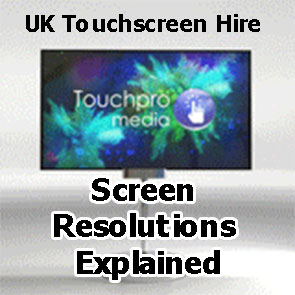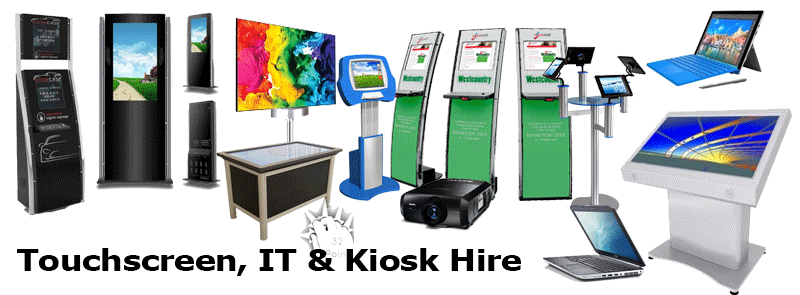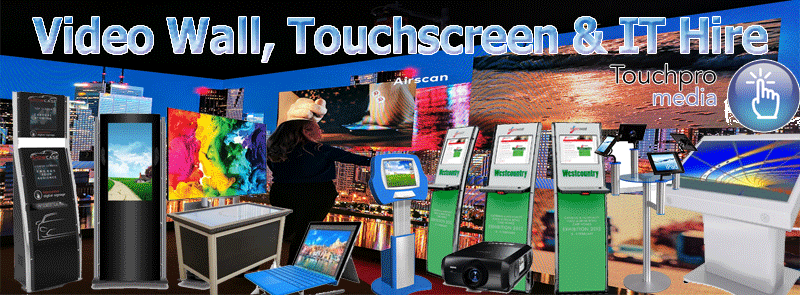
Different Types of Touchscreen Resolution Explained
| Call Us | Email Us | Website |
When we discuss touchscreen, video walls and monitor rentals with customers, often the conversation turns to the resolution of the screens.
The resolution of a screen refers to how many pixels the screen has in a certain recognized space.
A bigger screen does not necessarily have a better resolution (often it is the reverse) and a smaller screen does not necessarily have a worse resolution.
The resolution of a screen is unrelated to its size.
Resolution only really makes sense when given in a recognised unit of measure. The industry recognized standards are Pixels per inch (PPI) or pixels per centimeter (PPCM)
When given the resolution of screen do not be fooled that a big screen sounds like it has a better resolution.
Screen resolutions are often explained by the following abbreviations: SD (Standard Definition), HD (High definition), Full HD, 2K and 4K. 2K and 4k refers to the number of the pixels in the horizontal direction.
| Format | Resolution | Number of pixels |
|---|---|---|
| 480p / SD | 640×480 | 307,200 |
| 720p / HD | 1280×720 | 921,600 |
| 1080p / Full HD | 1920×1080 | 2,073,600 |
| 2K | 2048×1080 | 2,211,840 |
| 4K / Ultra HD | 3840×2160 | 8,294,000 |
Pixels are the points of light on a screen. We see an image on a screen because patterns of these change colour and create the correct colours to represent the picture sent to it.
You are not seeing the very thing you are looking at. So if a green field is broadcast to the screen you will see an imitation of it. Not a verbatim/identical copy. There is no camera that can make an identical copy of an image it is pointed it. For all intents and purposes it looks the same but in reality it is not. The quality of the image is limited to the number of the pixels on the screen and the space between them.
To a degree the concern over the resolution of a normal screen – whether a small tablet or a big 100 inch screen is a thing of the past. All modern screens, made by any manufacturer will have a clear and concise image. The image will largely depend on the quality of the graphic it is asked to display, not the screen itself.
In the past low quality screens could give a poor image in some circumstances and this was often said to be a pixelated image. That is that you got a sense of seeing individual pixels of colour that didn’t blend together to form the required image correctly.
In todays market what remains a consideration is the resolution of a Video Wall. These are giant screens that are made up of pixels that are much further spaced apart than on a normal monitor.
A smallish Video Wall is likely to be made up of normal screens interlinked and positioned side by side as seen below. In thsi instance the resolution will not be off concern and if a powerful enough computer with a high enough quality video driver is used to send the image – the overall image – even close up will not look at all pixelated. We always advise that our computers which have been specifically put together to undertake the job are used.
video-wall-resolution-pixels-explained-hire-event
Big Video walls have their pixel rate measured in P No’s. So P10 is a Video Wall that has pixels set 10mm apart (centre to centre of the pixel). P16 – 16mm.
The lower the P No. The better the quality – but the more expensive it will be.
How to choose the best Pixel Pitch size?
To choose the optimum pixel pitch two factors should be considered, the viewing distance and the required image resolution. Smaller pixel pitches are better all the time and deliver you better image quality but, it costs more. You may decrease the expenses of LED display buy using larger pixel pitch and still have almost same image quality if the viewing distance is longer than best viewing distance. The best viewing distance of a pixel pitch is the distance that your eyes won’t be able to the gaps between pixel anymore if you go further away.
Here is a great imafe of a screen designed by Samsung to show the differences.
video-wall-pixel-resolution-hire-explained
Take an LED sign with P10 modules (pixel pitch of 10mm). The minimum viewing distance for P10 is 10m and the best viewing distance is 20m. So, if people watch it from 10m to 50m away, they can see an acceptable image quality with a fading level of pixilation from 10m to 20m and a very good image quality after 20m. So you may want to increase the image quality using P8 or even P6 module for close range. But If the viewing distance was from 20m to 50m, there was no point to use smaller pixel pitch with higher resolution. Because, the viewing distance was already more than best viewing distance of P10.
As a rough estimation, P10 (10mm pixel pitch) is suitable for any outdoor application with viewing distance of 10m and more. P8 or P6 (6mm and 8mm pixel pitch) can also be used if target audience are in closer distance. For indoor applications, P6 may suit any advertising needs with viewing distance of 6m and more. P4 (4mm pixel pitch) can also be used if your audience are closer such as LED video wall in retail environment. For better estimation of pixel pitch you can use the following table.
| LED Modules | Pixel Pitch | Minimum Viewing Distance | Best Viewing Distance |
|---|---|---|---|
| P4 | 4mm | 4m | 8m |
| P6 | 6mm | 6m | 12m |
| P8 | 8mm | 8m | 16m |
| P10 | 10mm | 10m | 20m |
To read more on other types of touchscreens use the links below:
SAW Touchscreens Explained
Capacitive Touchscreens Explained
Infra Red Touchscreens Explained
Resistive Touchscreens Explained

Interested in hiring with us? Contact details below:

